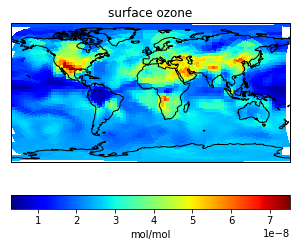Sample Python code to plot GCHP data¶
[1]:
%matplotlib inline
import numpy as np
import xarray as xr
import cartopy.crs as ccrs
import matplotlib.pyplot as plt
import cubedsphere as cs # https://github.com/JiaweiZhuang/cubedsphere
[2]:
ls ~/tutorial/gchp_standard/OutputDir/
FILLER
GCHP.SpeciesConc_avg.20160701_0030z.nc4
GCHP.SpeciesConc_inst.20160701_0100z.nc4
[3]:
ds = xr.open_dataset("~/tutorial/gchp_standard/OutputDir/GCHP.SpeciesConc_inst.20160701_0100z.nc4")
ds['SpeciesConc_O3']
[3]:
<xarray.DataArray 'SpeciesConc_O3' (time: 1, lev: 72, lat: 144, lon: 24)>
[248832 values with dtype=float32]
Coordinates:
* lon (lon) float64 1.0 2.0 3.0 4.0 5.0 6.0 ... 20.0 21.0 22.0 23.0 24.0
* lat (lat) float64 1.0 2.0 3.0 4.0 5.0 ... 140.0 141.0 142.0 143.0 144.0
* lev (lev) float64 1.0 2.0 3.0 4.0 5.0 6.0 ... 68.0 69.0 70.0 71.0 72.0
* time (time) datetime64[ns] 2016-07-01T01:00:00
Attributes:
long_name: Dry mixing ratio of species for O3
units: mol mol-1 dry
fmissing_value: 1000000000000000.0
standard_name: Dry mixing ratio of species for O3
vmin: -1000000000000000.0
vmax: 1000000000000000.0
valid_range: [-1.e+15 1.e+15]
[4]:
# get data at one level and reshape to 6 cubed-sphere panels
data = ds['SpeciesConc_O3'].isel(time=0, lev=0).data.reshape(6, 24, 24)
[5]:
grid = cs.csgrid_GMAO(24) # compute cubed-sphere coordinate values needed for plotting
[6]:
fig = plt.figure(figsize=[5, 4])
ax = plt.axes(projection=ccrs.PlateCarree())
ax.coastlines()
im = cs.plotCS_quick_raw(grid['lon_b'], grid['lat_b'],
data, grid['lon'], ax, cmap='jet', masksize=4)
cbar = fig.colorbar(im, orientation='horizontal')
cbar.set_label('mol/mol')
plt.title('surface ozone');
